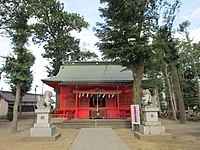Ono Shrine
Enshrined kami
The kami enshrined at Ono Jinja are:
- Ame-no-shitaharu-no-Mikoto (天下春命), ancestor of the Chichibu Kuni no miyatsuko
- Seoritsu-hime no Mikoto (瀬織津比咩命)
- Izanagi no Mikoto (伊弉諾尊)
- Susanoo no Mikoto (素盞嗚尊)
- Ōkuninushi (大己貴大神)
- Ninigi (瓊々杵尊)
- Hikohohodemi no Mikoto (彦火火出見尊)
- Ukanomitama (倉稲魂命)
History
The origins of Ono Jinja are unknown. The site of the provincial capital of Musashi Province are located nearby, and the shrine first appears in the historical record in 772, followed by a mention in the Nihon Sandai Jitsuroku in 884, and in the Engishiki, where it is listed as a minor shrine. It is styled as the "ichinomiya" of Musashi in the early Kamakura period Azuma Kagami and in the Nanboku-chō period Shintōshū.The shrine was rebuilt in the Sengoku period by the Late Hōjō clan and Ota Dokan and received a stipend in the Edo Period from the Tokugawa shogunate.
During the Meiji period era of State Shinto, the shrine was rated as a county shrine under the Modern system of ranked Shinto Shrines.
The shrine is located a six-minute walk from Seiseki-Sakuragaoka Station on the Keio Electric Railway Keio Line.
Gallery
-
Honden
-
Haiden'
-
Zuishin-mon
See also
References
- Plutschow, Herbe. Matsuri: The Festivals of Japan. RoutledgeCurzon (1996) ISBN 1-873410-63-8
- Ponsonby-Fane, Richard Arthur Brabazon. (1959). The Imperial House of Japan. Kyoto: Ponsonby Memorial Society. OCLC 194887
External links
![]() Media related to Ono-jinja (Tama) at Wikimedia Commons
Media related to Ono-jinja (Tama) at Wikimedia Commons
Notes
- ^ Shibuya, Nobuhiro (2015). Shokoku jinja Ichinomiya Ninomiya San'nomiya (in Japanese). Yamakawa shuppansha. ISBN 978-4634150867.
- ^ Yoshiki, Emi (2007). Zenkoku 'Ichinomiya' tettei gaido (in Japanese). PHP Institute. ISBN 978-4569669304.
- ^ Okada, Shoji (2014). Taiyō no chizuchō 24 zenkoku 'Ichinomiya' meguri (in Japanese). Heibonsha. ISBN 978-4582945614.


